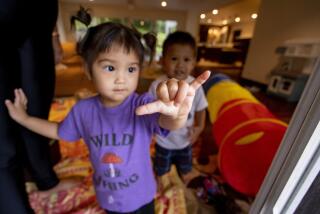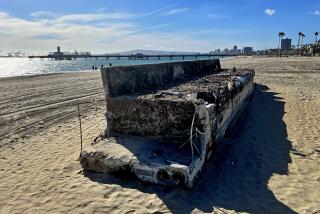After a spruce-up, Waikiki Beach looks even better
HONOLULU — The giant sandbox known as Waikiki Beach, a sunny two-mile-long strip of paradise, welcomes 4.5 million tourists annually.
There’s only one problem: The sand that makes the beach famous has been slipping into the sea for years, leaving an ever-shrinking shore with vacationers crowded beach mat to beach mat at water’s edge.
The last few times I visited, I steered clear of the beach because it didn’t seem like much fun. Too many people, too little space.
So it pleased me to learn about a beach-widening plan that revolved around pumping sand from a couple of spots offshore to the beach. Financed in large part by the state, the $2.5-million project has added 37 feet of sand to a one-third-mile stretch from Kuhio Beach north to the Royal Hawaiian Hotel.
I was impressed when I visited Waikiki in August, and not just by the expanded beach, which is one of many recent Waikiki improvements.
“People tell me Waikiki has never looked better,” said Rick Egged, president of the Waikiki Improvement Assn. “Basically, we’ve spent $3 billion during the past decade building a better product.”
The goal, of course, is to keep those tourist dollars rolling in, an effort that seems to be successful.
Statistics for this summer show that visitor arrivals and spending this year are on track to surpass 2012 figures, said Mike McCartney, president of the state-run Hawaiian Tourism Authority. That means $1.04 billion in state tax revenue, $50 million more than last year.
Once a favorite retreat of Hawaiian royalty, Waikiki is home to many of Oahu’s finest hotels and much of its dining, shopping and night life. But during the recession, visitor numbers dropped dramatically. The state’s tourism industry suffered another blow in 2011 when Japan was rocked by an earthquake and tsunami, suppressing the flow of wealthy Japanese vacationers.
“Waikiki recovered faster than other destinations because of the investment we made in improving it,” Egged said. A revitalization project that began in the late ‘90s and continued into the new century pumped more than a billion dollars into bettering Waikiki. Among the changes: beefing up crime prevention efforts, encouraging more upscale retail and adding more family-friendly entertainment.
Unless you know what to look for, you probably won’t notice most of the changes. They just make Waikiki a nicer place to visit. As I walked along Kalakaua Avenue, the main thoroughfare, I saw broad, newly tiled walkways and flowers spilling out of lamppost baskets. I also noticed both high-end and moderately priced shops and new upscale shopping centers. In the past, Waikiki seemed to have only ultra-expensive stores or trinket shops.
When I reached the International Market Place, I paused. This probably would be the last time I would see the Waikiki landmark. The open-air center, built in the 1950s, is a maze of small, aging souvenir shops and carts featuring T-shirts, shell jewelry and tropical-print clothing. It’s scheduled for redevelopment, with the groundbreaking planned for late this year or early next year.
The new Market Place will look vastly different. Plans for the new three-story center call for it to be anchored by a Saks Fifth Avenue department store and include 60,000 square feet of retail, dining and entertainment space on six acres, with a completion date in 2016.
I crossed the street to the Moana Surfrider, a Honolulu landmark that’s nicknamed the “First Lady of Waikiki.” The colonial-style Moana opened in 1901, ushering in tourism in the Hawaiian Islands. The beachfront hotel has always seemed an oasis of gentility, complete with afternoon teas and a history room recounting the early days of Hawaiian hospitality.
The Moana underwent a major renovation in 2007, when it became part of the Westin-Starwood family. In August, a $9-million renovation was completed on its Tower Wing rooms, adding contemporary Hawaiian furnishings and a beachy, ocean-inspired look. I took a tour; the rooms were serene and the views spectacular.
But good things come in smaller packages too, and my next stop was the Shoreline Hotel Waikiki, a couple of blocks inland, which opened in the spring. The Shoreline is one of several aging hotels that have been renovated recently and opened as cosmopolitan boutiques.
Waikiki doesn’t have room to build new hotels, so it makes sense that developers would upgrade some of the aging ones. Many have bargain rates, a real plus.
Among the new hotels: Vive Waikiki, which opened in July; Hotel Renew by Aston; Coconut Hotel Waikiki; Hyatt Place Waikiki Beach ; and the Modern Honolulu, a chic hotel that contains one of Oahu’s most popular night clubs, Addiction, as well as the Study for younger crowds.
It’s probably too early to say how much impact the hotel renovations will have on visitor numbers. But one thing is certain. Statistics released earlier this month indicated that Hawaii hotels are setting all-time records. Total revenue hit $1.43 billion this summer, 8 1/2 % over the same period in 2012.
“We had 93% occupancy this summer,” Egged said. “That’s what we want: to give people great hotels, shops, food and entertainment and let them appreciate this beautiful island.
More to Read
Sign up for The Wild
We’ll help you find the best places to hike, bike and run, as well as the perfect silent spots for meditation and yoga.
You may occasionally receive promotional content from the Los Angeles Times.






